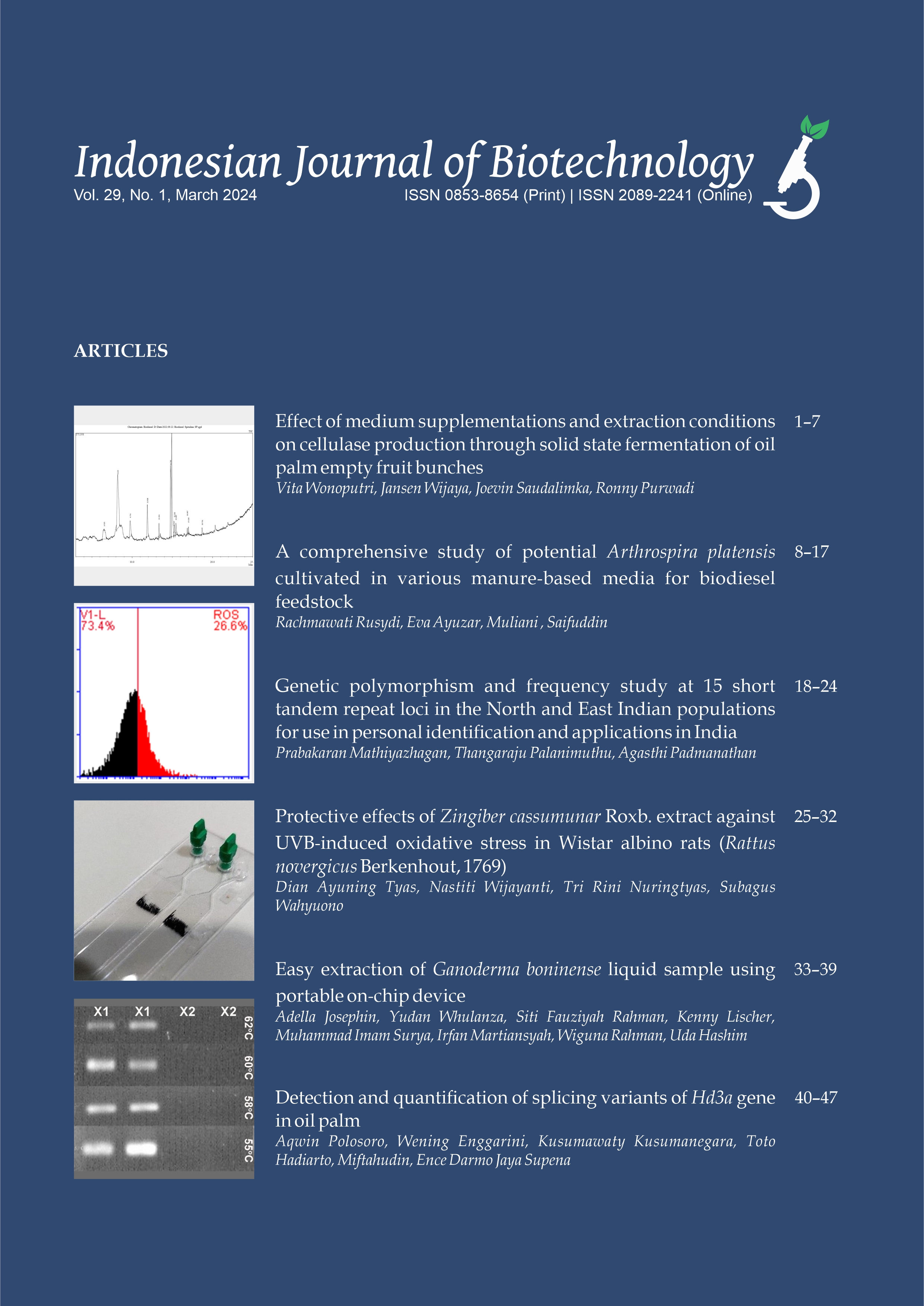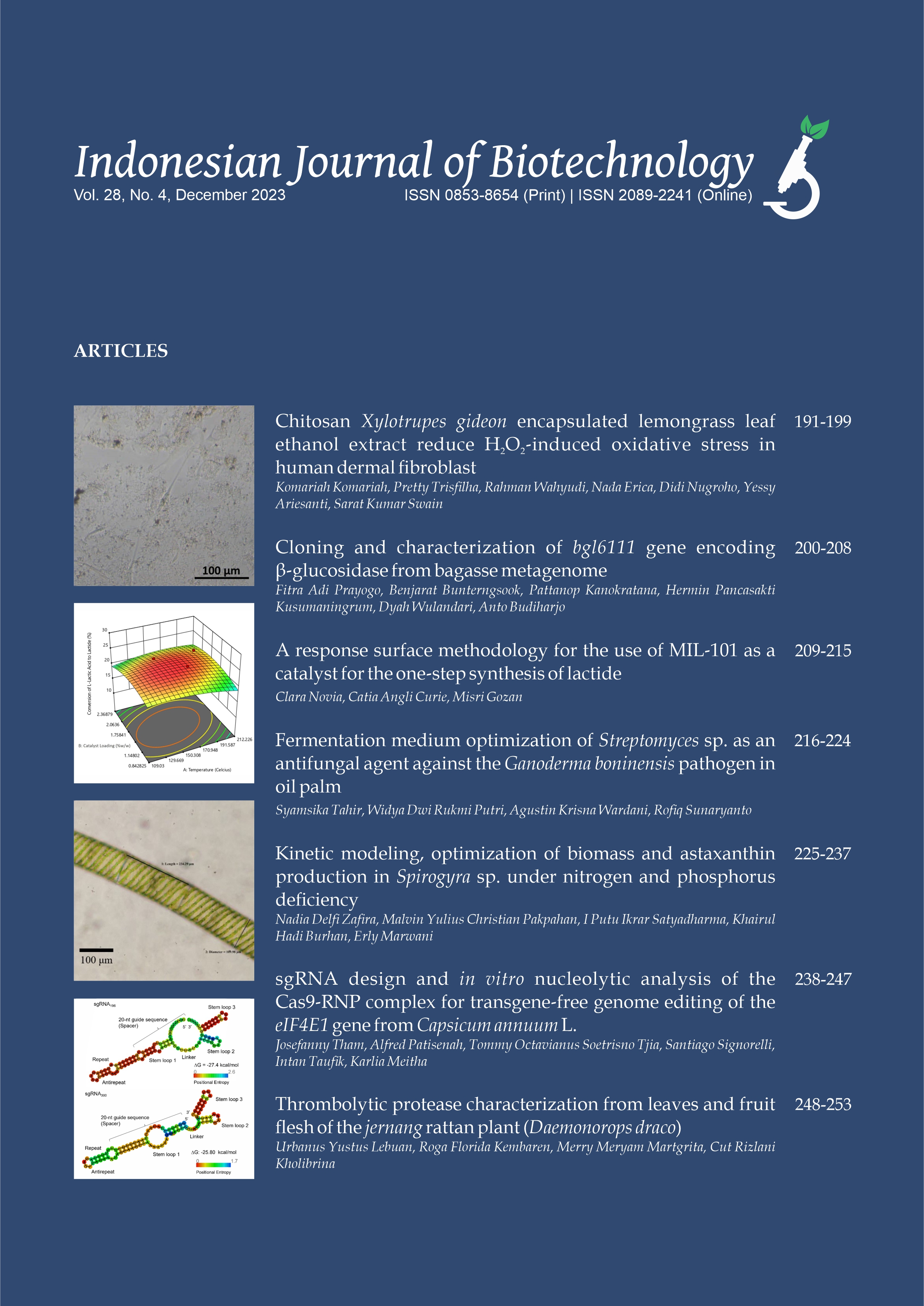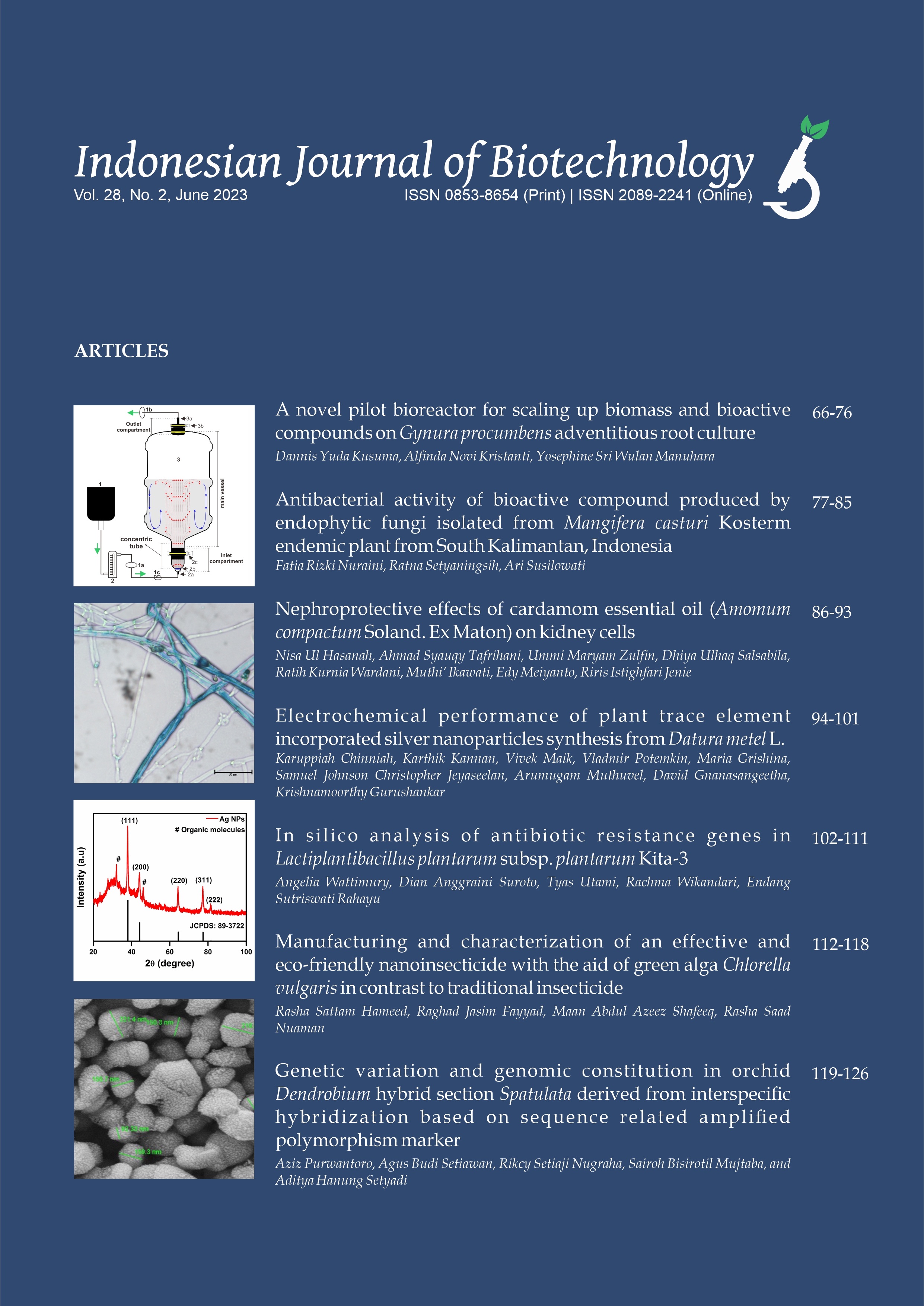Cloning and expression of haloacid dehalogenase gene from Bacillus cereus IndB1
Enny Ratnaningsih(1), Idris Idris(2*)
(1) Biochemistry Research Division, Department of Chemistry, Faculty of Mathematics and Natural Sciences, Institut Teknologi Bandung, Jalan Ganesha 10, Bandung 40132, Indonesia
(2) Universitas Islam Negeri Sultan Maulana Hasanuddin Banten, Jalan Jend. Sudirman No. 30 Serang, Banten 42118, Indonesia
(*) Corresponding Author
Abstract
Keywords
Full Text:
PDFReferences
Arif F. 2013. Cloning and sequencing of haloacid dehalogenase gene from Bacillus cereus local strain [Bachelor thesis]. [Bandung, Indonesia]: Institut Teknologi Bandung.
Bergmann JG, Sanik J. 1957. Determination of trace amounts of chlorine in naphtha. Anal Chem. 29:241–243. doi:10.1021/ac60122a018.
Bradford MM. 1976. A rapid and sensitive method for the quantitation of microgram quantities of protein utilizing the principle of protein-dye binding. Anal Biochem. 72:248–254. doi:10.1016/0003-2697(76)90527-3.
Chen VB, Arendall WB, Headd JJ, Keedy DA, Immormino RM, Kapral GJ, Murray LW, Richardson JS, Richardson DC. 2010. MolProbity: all-atom structure validation for macromolecular crystallography. Acta Crystallographica Section D Biological Crystallography 66:12–21. doi:10.1107/S0907444909042073.
Choi JH, Keum KC, Lee SY. 2006. Production of recombinant proteins by high cell density culture of Escherichia coli. Chem Eng Sci. 61:876–885. doi:10.1016/j.ces.2005.03.031.
Cohen SN, Chang AC, Boyer HW, Helling RB. 1973. Construction of biologically functional bacterial plasmids in vitro. Proc. Natl. Acad. Sci. U.S.A. 70:3240–3244.
Hardman DJ, Slater JH. 1981. The dehalogenase complement of a soil pseudomonad grown in closed and open cultures on haloalkanoic acids. Microbiology 127:399–405. doi:10.1099/00221287-127-2-399.
Hill KE, Marchesi JR, Weightman AJ. 1999. Investigation of two evolutionarily unrelated halocarboxylic acid dehalogenase gene families. J Bacteriol. 181:2535–2547.
Huyop FZ, Yusn TY, Ismail M, Wahab RA, Cooper RA. 2004. Overexpression and characterisation of non-stereospecific haloacid dehalogenase E (DehE) of Rhizobium sp. Asia Pac J Mol Biol Biotechnol. 12:15–20.
Kawasaki H, Tsuda K, Matsushita I, Tonomura K. 1992. Lack of homology between two haloacetate dehalogenase genes encoded on a plasmid from Moraxella sp. strain B. J Gen Microbiol. 138:1317–1323. doi:10.1099/00221287-138-7-1317.
Kurihara T, Esaki N, Soda K. 2000. Bacterial 2-haloacid dehalogenases: structures and reaction mechanisms. J Mol Catal B: Enzym. 10:57–65. doi:10.1016/S1381-1177(00)00108-9.
Liu JQ, Kurihara T, Hasan AK, Nardi-Dei V, Koshikawa H, Esaki N, Soda K. 1994. Purification and characterization of thermostable and nonthermostable 2-haloacid dehalogenases with different stereospecificities from Pseudomonas sp. strain YL. Appl Environ Microbiol. 60:2389–2393.
Maier RM, Pepper IL, Gerba CP. 2009. Environmental microbiology. San Diego (California): Academic Press.
Novak HR, Sayer C, Panning J, Littlechild JA. 2013. Characterisation of an L-haloacid dehalogenase from the marine psychrophile Psychromonas ingrahamii with potential industrial application. Mar Biotechnol. 15:695–705. doi:10.1007/s10126-013-9522-3.
Olaniran AO, Pillay D, Pillay B. 2004. Haloalkane and haloacid dehalogenases from aerobic bacterial isolates indigenous to contaminated sites in Africa demonstrate diverse substrate specificities. Chemosphere 55:27–33. doi:10.1016/j.chemosphere.2003.10.067.
Pacheco B, Crombet L, Loppnau P, Cossar D. 2012. A screening strategy for heterologous protein expression in Escherichia coli with the highest return of investment. Protein Expression Purif. 81:33–41. doi:10.1016/j.pep.2011.08.030.
Ridder IS, Rozeboom HJ, Kalk KH, Janssen DB, Dijkstra BW. 1997. Three-dimensional structure of l-2-haloacid dehalogenase from Xanthobacter autotrophicus GJ10 complexed with the substrate-analogue formate. J Biol Chem. 272:33015–33022. doi:10.1074/jbc.272.52.33015.
Römpp A, Klemm O, Fricke W, Frank H. 2001. Haloacetates in fog and rain. Environ Sci Technol. 35:1294–1298.
Sahdev S, Khattar SK, Saini KS. 2007. Production of active eukaryotic proteins through bacterial expression systems: a review of the existing biotechnology strategies. Mol Cell Biochem. 307:249–264. doi:10.1007/s11010-007-9603-6.
Schein CH, Noteborn MHM. 1988. Formation of Soluble Recombinant Proteins in Escherichia Coli is Favored by Lower Growth Temperature. Nat Biotechnol. 6:291–294. doi:10.1038/nbt0388-291.
Torz M, Beschkov V. 2005. Biodegradation of monochloroacetic acid used as a sole carbon and energy source by Xanthobacter autotrophicus GJ10 strain in batch and continuous culture. Biodegradation 16:423–433. doi:10.1007/s10532-004-3614-8.
Tsang JSH, Sam L. 1999. Cloning and characterization of a cryptic haloacid dehalogenase from Burkholderia cepacia MBA4. J Bacteriol. 181:6003–6009.
Zhang Y. 2008. I-TASSER server for protein 3D structure prediction. BMC Bioinformatics 9:40. doi:10.1186/1471-2105-9-40.
Article Metrics
Refbacks
Copyright (c) 2017 The Author(s)

This work is licensed under a Creative Commons Attribution-ShareAlike 4.0 International License.









